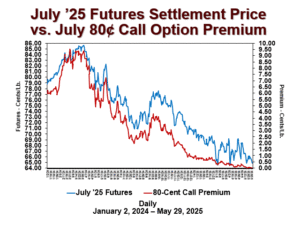Another common hedging strategy for growers is to fix the cash price (either with a forward contract, a pool contract, or a post-harvest spot contract) and then buy a call option. Call options premiums (the red line above) increase in value with increases in the futures market price (the blue line below). This is because the owner of a call option has the right, but not the obligation, to have bought the futures market at the call strike price. Hence owning a call option represents insurance against selling your cash cotton and then missing out on a later price rally. It is also a substitute/compensation for storing your cotton for later cash sale (or for putting it in the CCC loan for later sale).
Looking an example for the 2024 crop, this graph above shows the value of an 80 cent Jul’25 call option premium (traced by the red line). The call premiums tracked the movement of the underlying Jul’25 ICE cotton futures price (in blue). As visible in the chart, as Jul’25 futures have risen and fallen, the premium value of Jul’25 call options moves in the same direction.
In a hedging sense, call option strategies for growers are bought as insurance against missing out on a post-harvest rally in prices. Call option strategies therefore make sense when combined with cotton that was been cash contracted. For example, suppose a grower sold his 2024 bales for a cash price in the low to mid 70s. A deeply out-of-the-money 80 strike call option on Jul’25 futures could have been purchased very cheaply. But while cheap insurance, this year is an example when the insurable event (a major old crop price rally) did not happen. That’s ok as long as the insurance didn’t cost much.
The same logic applies to mill buyers who buy cotton on-call (i.e., fix the basis now and fix the futures price later). These mill buyers probably expected the futures price to decline. The purchase of a call option is insurance against rising prices. Mill buyers can pencil out a maximum purchase price by adding together the call option strike price (85 cents per pound in the above example) plus their buying basis, e.g., 5 to 8 cents a pound, plus the call option premium cost (hopefully purchased back when it was more affordable).
